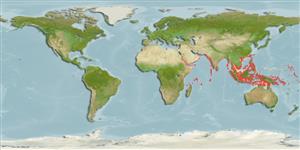Common names from other countries
sub class Elasmobranchii (ฉลามและกระเบน) (sharks and rays) >
Carcharhiniformes (Ground sharks) >
Carcharhinidae (Requiem sharks)
Etymology: Carcharhinus: karcharos (Gr.), sharp or jagged; rhinus, an ancient name for sharks, from rhine (Gr.), rasp, both words alluding to a shark's jagged, rasp-like skin. (See ETYFish); hemiodon: hemi-, from hemisys (Gr.), half; odon (Gr.), tooth, allusion not explained, perhaps referring to how teeth on upper jaw are serrated basally and smooth distally. (See ETYFish).
Environment: milieu / climate zone / depth range / distribution range
นิเวศวิทยา
เกี่ยวกับทะเล,น้ำเค็ม; กร่อย สัตว์น้ำหน้าดิน; สัตว์น้ำที่อพยพไปๆมาๆ ระหว่างแหล่งน้ำจืดกับทะเล ที่เป็นไปตามช่วงชีวิต (Ref. 51243); ระดับความลึก 10 - 150 m (Ref. 106604). Deep-water; 25°N - 13°S
Indo-West Pacific: Gulf of Oman to Pakistan, India, and possibly Sri Lanka. Scattered localities from the eastern Indian Ocean and the western Pacific ranging from India to New Guinea.
ขนาด / น้ำหนัก / Age
Maturity: Lm ? range ? - ? cm
Max length : 200 cm TL เพศผู้/กระเทย; (Ref. 9997)
เงี่ยงครีบหลัง (รวม) : 0; เงี่ยงครีบก้น: 0. Grey above, white below, with the tips of the pectorals, and upper and lower caudal-fin lobes black; other fins dusky (Ref. 9997).
A little-known shark found on the continental and insular shelves (Ref. 244). Reports from river mouths and rivers are based on old records that need verification (Ref. 9997). Probably feeds on small fishes, cephalopods, and crustaceans (Ref. 9997). Viviparous (Ref. 50449). Utilized fresh for human consumption (Ref. 9997).
Life cycle and mating behavior
Maturities | การสืบพันธุ์ | Spawnings | Egg(s) | Fecundities | ตัวอ่อน
Distinct pairing with embrace (Ref. 205). Viviparous, placental (Ref. 50449).
Compagno, L.J.V., 1984. FAO Species Catalogue. Vol. 4. Sharks of the world. An annotated and illustrated catalogue of shark species known to date. Part 2 - Carcharhiniformes. FAO Fish. Synop. 125(4/2):251-655. Rome: FAO. (Ref. 244)
IUCN Red List Status (Ref. 130435)
Human uses
การประมง: การประมงยังชีพ
เครื่องมือ
Special reports
Download XML
แหล่งที่มาจากอินเตอร์เน็ต
Estimates based on models
Preferred temperature (Ref.
115969): 25.2 - 29.1, mean 28.3 (based on 844 cells).
Phylogenetic diversity index (Ref.
82804): PD
50 = 0.5000 [Uniqueness, from 0.5 = low to 2.0 = high].
Bayesian length-weight: a=0.00479 (0.00221 - 0.01036), b=3.09 (2.92 - 3.26), in cm Total Length, based on LWR estimates for this Genus-body shape (Ref.
93245).
ระดับชั้นอาหาร (Ref.
69278): 4.2 ±0.58 se; based on food items.
ความสามารถในการกลับคืนสู่ปกติ (Ref.
120179): ต่ำ, เวลาต่ำสุดที่จะทำให้ประชากรเพิ่มขึ้นเป็น 2 เท่าใช้เวลา 4.5 - 14 ปี (Fec assumed to be <100).
Fishing Vulnerability (Ref.
59153): Very high vulnerability (90 of 100).
